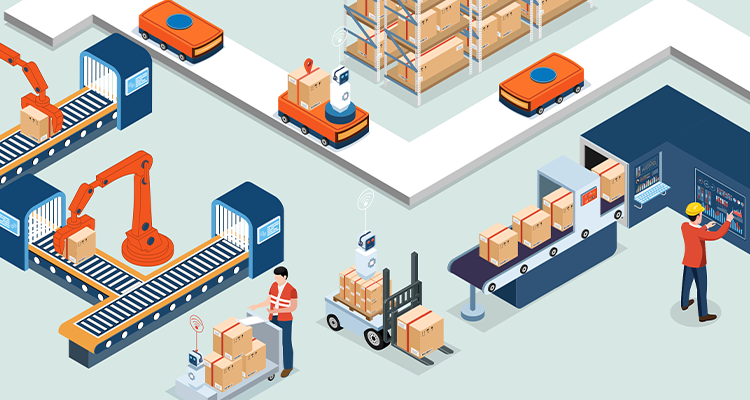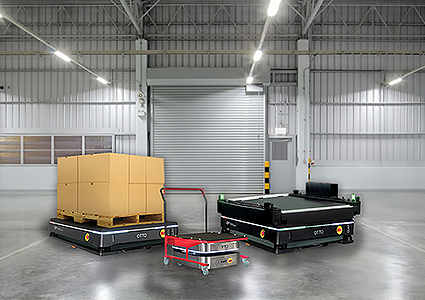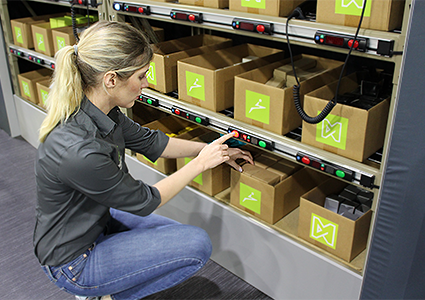
Unlocking the Power of Retail Logistics Automation: Improving Efficiency, Productivity, and Staff Well-being
Retail logistics automation has never been more important. In a tough economic market, slow and inaccurate picking can wipe out margin, especially when errors contribute to expensive returns. Staff shortages are adding to inefficiency and workplace stress, making it vital to create a more attractive working environment, preferably one that minimizes heavy lifting and enables staff to be quickly productive.
 Retail and logistics businesses recognize that automation improves the effectiveness and accuracy of warehouse operations. They know it can improve responsiveness and reduce costly picking errors, while also enhancing day-to-day staff experience, safety, and well-being. Yet far too many companies have held back from embracing automation due to a fear of business disruption and a lack of available investment funds.
Retail and logistics businesses recognize that automation improves the effectiveness and accuracy of warehouse operations. They know it can improve responsiveness and reduce costly picking errors, while also enhancing day-to-day staff experience, safety, and well-being. Yet far too many companies have held back from embracing automation due to a fear of business disruption and a lack of available investment funds.
The good news is that automation doesn’t have to be disruptive or expensive. From Autonomous Mobile Robots (AMRs) to Pick-to-Light solutions and Warehouse Execution Systems, with the right approach, companies can embrace automation step-by-step, adding value and building confidence with every small change.
Empowering staff productivity
Operational effectiveness can be influenced by a range of factors, but in 2023 the key issue for the majority of retail and logistics operations is staff: their recruitment, retention, well-being and productivity. The challenges associated with retaining and recruiting staff are well documented. In addition to seeking help from the government to address the estimated shortage of 60,000 drivers and warehouse operatives, many businesses have been compelled to increase salaries, with one discount supermarket increasing its hourly rate for warehouse workers by 20 percent over the past year.
Furthermore, retailers and logistics companies are increasingly aware of the need to improve safety and well-being within a highly physical environment. Not only are companies under pressure to comply with regulatory demands for employee health and safety, unless the warehouse environment experience improves, companies will struggle to attract new staff.
Add in the continued impact of global inflation and supply chain disruption, and retailers are under enormous pressure to achieve new levels of efficiency and cost effectiveness from existing operations.
Power of automation
Automation provides a chance to address a range of operational needs:
Transforming productivity: Autonomous mobile robots (AMRs) can reduce the time spent by workers walking around the warehouse facility. Indeed, AMRs are incredibly flexible, with add-on options, such as picking arms, barcode readers, cameras or grabbing mechanisms, meaning they can be deployed in different areas of the warehouse as required. Software solutions such as Warehouse Execution Systems help to optimize operations and Pick-to-Light technology can transform the speed and accuracy of stock picks, improving responsiveness and reducing the costs associated with unnecessary product returns.
Improving staff well-being: Manual handling injuries are still surprisingly widespread within retail, with around one million working days lost due to handling injuries every year. In addition to the impact on staff, this is a significant business expense: what is it costing in delayed order fulfilment when staff are off sick or must be replaced by temporary staff? Automation can radically reduce the need for employees to carry heavy items, as AMRs take over much of the heavy lifting and carrying. By reducing the physical demands on staff, a company not only cuts the risk of injury but also frees up staff to undertake added value roles – such as quality assurance. Together these changes can make the working environment more accessible to a broader pool of potential talent. 
Improving seasonal agility: Adding robots also provides contingency, especially at peak season, with the chance to rent additional units giving retailers a quick, low-cost way to scale up resources. In addition, the simplicity of Pick-to-Light systems, where lights guide staff to the right location for each pick or put, means that staff require minimal training to become productive. Even occasional agency staff can be as effective, efficient, and accurate as long- standing employees.
Getting started
The good news for companies is that these technologies can be added without disruption or upheaval. It is a simple process to add one or two AMRs into one area of operation to reduce the amount of time spent walking by humans. An AMR can be used at the end of an aisle, for example, to then transfer goods to the packing area, allowing staff to concentrate on picking rather than walking miles around the warehouse. There are no complex integrations to worry about. An AMR can be summoned by an individual pressing a button when the goods are ready to be moved; or triggered by a simple light beam.
Not only can this automation be introduced seamlessly to the existing set up, but AMRs can even be trialed without cost with the right business partner. The only change that may be required is to clean up the environment: while AMRs can navigate around empty boxes and polythene shrink wrap, they will have to slow down to avoid these hazards, thus reducing their overall efficiency. Training staff to tidy up as they go is a valuable step in achieving a more effective human/AMR operation.
Once a company has experienced the ease with which an AMR or two can work side by side with human staff, the business may then evaluate the benefits of adding Pick-to-Light to reduce the error rate and improve efficiency. Or think about adding warehouse execution to further automate and optimize tasks. The entire automation journey can be achieved step by step, reflecting a business’ needs and investment options – with the added benefit that the entire organization gains both incremental benefits and technology confidence.
Conclusion
Automation is becoming essential. When retail competitors can achieve a business model that is not only far more responsive to customer needs, but also at a lower cost base, the pressure to adapt is growing fast. And for any company struggling to work out where to prioritize, there is help available. Working with a partner who can assess the current operational environment and suggest where an AMR could reduce human miles or take on the heavy lifting, or why Pick-to-Light could resolve picking errors, can help to refine plans.
With the addition of a free AMR trial, concerns regarding both cost and disruption are addressed. Retail and logistics operations can confidently explore the power of automation to support the existing human workforce to be both productive and safe. It’s time to get started on automation.
For a list of the sources used in this article, please contact the editor.
Dr Paul Rivers
www.guidanceautomation.com
Dr Paul Rivers is CEO of Guidance Automation, an award-winning pioneer of autonomous mobile robot technologies. Its suite of flexible and robust products is at the forefront of innovation, featuring autonomous material transportation, light-directed handling, and warehouse execution and control systems. It incorporates conveyors, sorters, robotic arms, and numerous other state-of-the-art automation technologies to deliver a comprehensive and bespoke solution for each unique business application.